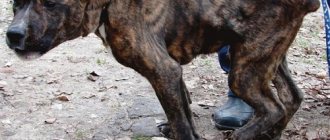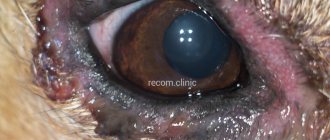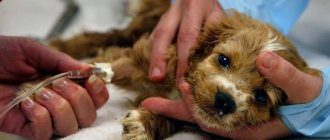Pain shock in dogs, symptoms of pain shock in dogs
When a pet gets sick, it can be confusing for its owner.
Unlike people, our smaller brothers are dumb and cannot talk about what they experience. If you do not pay due attention, you may encounter certain difficulties in further treatment. Therefore, it is important to promptly contact a competent veterinary surgeon who can make the correct diagnosis and perform the necessary operation. Painful shock in dogs rarely occurs without symptoms. Based on a number of signs, you can quickly suspect that your pet is getting sick. You can find out how to treat this disease by contacting our 24-hour veterinary clinics in St. Petersburg, Veliky Novgorod, Pskov.
Canine shock, or How to treat “firecracker syndrome” in pets
The audio tag is not supported by your browser. The night of January 1st is the loudest of the year. Volleys of fireworks thunder in both big cities and small villages. People are happy about it. But not always for animals.
The roar of fireworks and firecrackers frightens all animals - both wild and domestic. But, as experts say, all this cannonade affects the wild ones to a lesser extent. For example, the same city birds simply fly away and sit out in the forest, in vacant lots or in empty dachas. And even then not all.
— Birds living near humans, especially in big cities, get used to constant noise. Therefore, even the sound of fireworks will not be something particularly shocking for them,” says Mikhail Korepov, associate professor of the Department of Biology and Chemistry at Ulyanovsk State Pedagogical University, ornithologist.
According to Mikhail, it would be much worse if such a “show” took place in the spring, during the nesting period. During this period, birds are especially shy. In particular, this is why ornithologists oppose spring hunting, the noise from which harms even those birds that are not shot.
But who is really afraid of the New Year's cannonade are pets. Especially dogs. According to Svetlana Strunnikova, a dog handler from Ulyanovsk, fear of sharp sounds is a protective reaction of the body. A person also experiences a similar fear, but he can distinguish when his life is in danger. A four-legged friend is more sensitive to noise and is unable to cope with his phobias on his own; he needs the help of his owner. Moreover, this does not depend on the breed. Both small pugs and large watchdogs are afraid of cannonades.
— You can understand that your dog is afraid of loud noises by several clear signs. This is trembling, pursed ears, shortness of breath, the dog may even wet itself. The animal begins to rush around and hides in a dark, far corner,” says Svetlana Strunnikova.
In order to reduce the shock, owners can take several fairly simple measures. 10 - 14 days before firecrackers and fireworks begin to rattle in the street, the dog should be given B vitamins, and five to seven days - a herbal sedative that is suitable for the pet. These drugs can be bought at veterinary pharmacies.
— At home, you should try to curtain all the windows, turn on the lights, and minimize loud noises. You should go for a walk during quiet hours, avoiding drunken companies and groups of teenagers, because both of them amuse themselves by unexpectedly throwing firecrackers. And of course, never let your dog off the leash. Directly on New Year's days, when the dog is experiencing the greatest stress, take treats and toys with you so that you can switch attention, says Svetlana Strunnikova.
It’s also worth preparing for New Year’s Eve, which marks the peak of stress for animals. Svetlana Strunnikova advises feeding the dog in advance, giving a tasty chew toy and being close to the dog. And in the worst case, have heart drops in stock, because it happens that dogs have an attack from shock.
If your dog is not yet an adult, then you can train it so that it does not react sharply to loud sounds. You need to start with the puppy. When a dog is playing with other dogs or is simply distracted by something, you need to explode one or two small firecrackers at the maximum distance from it, and then switch it back to play. Gradually this distance should be reduced. This way the dog will get used to sudden loud noise and will not be scared on New Year's Eve. In a similar way, Svetlana Strunnikova recommends training dogs to sparklers.
— Light a sparkler at home and sometimes play with it with your dog. But not with the fire itself, but to the side, unobtrusively. So that the dog gets used not only to loud sounds, but also to bright light, says the dog trainer.
These trainings, whether with firecrackers or sparklers, need to start as early as possible, so that by the New Year your four-legged friend will no longer be afraid of anything.
Ivan SONIN
Symptoms of painful shock:
- Change in body temperature.
- Loss of appetite, apathy.
- Excessive sleepiness.
- Disorders of urination and stool.
- The appearance of cough, shortness of breath.
- Intense thirst.
- The nose becomes dry and hot.
When dogs experience painful shock, there is a change in behavior. A healthy animal is active and cheerful. He has a good appetite and regular bowel movements and urination. You must react sensitively to the slightest changes in your pet's lifestyle.
It would be best to seek treatment from doctors with extensive experience in the Kotonai clinics in St. Petersburg, Pskov, and Veliky Novgorod. We recommend entrusting the treatment of your pet to professionals.
First symptoms
Clinical manifestations of anaphylactic shock are varied. Veterinary specialists distinguish the following variants of manifestation of sensitization of the body:
- Asphyxial. As a rule, the pathology begins with the development of redness, rash, and skin itching. The reaction to a foreign substance quickly develops from local to general. The animal has swelling of the mucous membrane of the nose, mouth, and larynx. These phenomena make breathing difficult. The dog's barking becomes hoarse. Spasm of the respiratory tract leads to blue mucous membranes.
- Hemodynamic shock . Collapse is caused by abnormal blood pressure (hypotension). Blood pressure levels can drop to critical levels, causing cardiac arrest, heart attack or stroke. Against the background of impaired blood supply during anaphylactic shock, pulmonary edema develops, which has dangerous consequences for the animal.
- Cerebral. The symptomatic complex includes deep lesions of the central nervous system. A sick animal experiences fear, hides in a corner, whines, and reacts inadequately to external stimuli. Often the dog may make aimless circular movements and stand with its head against the wall. With the cerebral variant of the manifestation of sensitization, convulsions are observed, often ending in the death of the pet.
- The thromboembolic nature of the symptoms of anaphylactic shock is life-threatening for the dog. The animal instantly develops cyanosis associated with blockage of the lumen of large arteries by a thrombus. There is shortness of breath, suffocation and rapid death.
- the abdominal variant of the course of collapse for symptoms of acute enteritis. The dog has severe vomiting and pain in the abdominal area. The animal whines in pain. Visible mucous membranes quickly turn pale.
Veterinary specialists distinguish between the early and deep phases of anaphylactic shock. During the early phase of collapse, the dog exhibits the following signs:
- tachycardia, rapid and confused breathing;
- anemia of the mucous membranes;
- change in the pet’s behavior: the dog is worried, whines, shows fear of familiar objects and people;
- depression, apathy, lethargy;
- increased salivation;
- aimless movements, sometimes the animal moves in an imaginary circle;
- body temperature is within the physiological norm.
With deep collapse, a dog may experience the following symptoms:
- lack of reaction of the body to external stimuli (sound, light), empty, meaningless look;
- rare and shallow breathing, bradycardia, arrhythmia;
- Body temperature can drop to 36 C.
With the development of anaphylactic shock due to the ingestion of a foreign protein (pollen, antibiotic, vaccine, etc.) into the body, itching, skin rashes, and urticaria are most often observed. In the absence of help, sensitization quickly leads to generalization of the pathological process.
As a result of the development of traumatic shock, the owner more often encounters such phenomena as lethargy, apathy, hypothermia, and disorders of the central nervous system.
About Quincke's edema in dogs, watch this video:
What can you do at home?
It is not always possible to immediately contact a veterinarian after detecting suspicious symptoms. And then a logical question arises: what to do to treat pain shock at home?
- Provide rest to the sick person.
- Isolate from other pets and people.
- Drink as often as possible.
- Measure the temperature with a regular or special veterinary thermometer. It needs to be lubricated with Vaseline and inserted into the rectum.
- Measure your pulse. To do this, you need to place your fingers on the femoral artery.
- Measure the breathing rate (by movement of the chest or wings of the nose).
Veterinarian help
Unfortunately, pain shock is more common in dogs than you might imagine. Surgery can save your pet's life. You don’t have to worry - a good specialist will help your pet get rid of the disease forever.
Painful shock has been well studied today. If you consult a surgeon in a timely manner, you can talk about a positive prognosis. Make an appointment with a doctor at our clinic, and we will do everything possible to restore your pet’s health.
Causes of the disease
There are several causes of anaphylaxis in dogs.
- Insect bites. Ingestion of poisons into a dog's body is the most common cause of anaphylactic shock. Anaphylaxis can result from a bee, bumblebee, wasp, tarantula, snake or spider sting.
- Medicines. Drugs can cause anaphylactic shock. The most common pathogens are antibiotics, general anesthetics, non-steroidal anti-inflammatory drugs, muscle relaxants, and radiocontrast agents.
- Hormones and serums. Anaphylactic shock can be caused by the administration of drugs such as insulin, ACTH, progesterone and others.
- Enzymes. Anaphylactic shock can occur with artificial administration of streptokinase, trypsin, asparaginase, and chymotrypsin.
- Vaccines and chemotherapy drugs. Anaphylaxis can be caused by drugs such as vincristine, methotrexate and cyclosporine.
General information
When an allergenic substance enters the dog's body again, many mast cells are released. They, in turn, produce a large number of mediators. The latter generate severe inflammation and lead to a state of shock. All this leads the animal to possible malfunction of internal organs and, possibly, death.
Causes of anaphylaxis in dogs
Absolutely any substance can trigger anaphylactic shock in dogs if the dog has a reaction to it. Basically, these are chemicals that are used to poison various pests or weeds. In addition, proteins in allergenic foods, vaccinations, and certain medications can cause a reaction. In addition, insect bites can provoke anaphylactic shock.
Signs of anaphylactic shock in a dog
The onset of allergic shock can be recognized by various signs. They differ depending on the specific allergen, as well as its amount and the body's reaction to the intake of this substance.
For example, if a dog has been stung by a wasp or bee, it will experience allergic swelling at the site of the bite. If the case is more complex, then the dog may experience swelling of the throat, which will consequently lead to the impossibility of air intake if measures are not taken in time.
In case of an allergy to chemicals entering the esophagus, the body's response will be similar to ordinary food poisoning. There will be diarrhea, vomiting, rapid heartbeat, convulsions, and increased salivation.
Severe cases of allergies provoke damage to the animal's brain and nervous system. Signs of this are the dog’s anxiety, fearfulness, increased activity, manifestations of fear, and convulsions.
IMPORTANT! The most sensitive organ in dogs is the liver. Therefore, the main symptom is indigestion.
The dog owner should immediately take the pet to the doctor if his pet exhibits the following symptoms:
- - swelling, redness or itching at the site of contact with the allergen;
- - unexpected diarrhea;
- - sudden manifestations of joy without reason;
- - vomit;
- - cardiopalmus;
- - labored breathing;
- - weak pulse;
- - seizures;
- - coma.
NOTE! It happens that anaphylaxis is accompanied by less dangerous symptoms. But it is necessary to pay attention to all symptoms, since if the same substance is subsequently ingested into the body, the reaction may be more serious.
It is necessary to pay attention to the following symptoms of the animal’s reaction to incoming allergens:
- — skin problems at the site of contact with the allergen: redness, swelling;
- - itching or rash;
- - cough that becomes chronic;
- - vomiting as a reaction to taking certain foods;
- - heavy breathing while running or other physical activity.
During the development of severe forms of allergies, the dog becomes lethargic, depressed, its heart rate slows down, its blood pressure decreases, breathing becomes difficult, and coma occurs.
Symptoms of the disease
Regardless of the cause, the symptoms of shock are the same. The first signs of anaphylaxis are:
- Skin irritation – redness, blisters, rash.
- Anginoneurotic edema - swelling of the deep layers of the skin and subcutaneous tissues.
- Nausea, vomiting, possible diarrhea.
Systemic anaphylaxis is the most dangerous form of the disease, affecting the dog's liver. The first signs of this disease are respiratory failure, vomiting, decreased reaction, and possible development of cardiovascular or muscle collapse.
Treatment of the disease
If symptoms of the disease appear, the dog owner must take immediate anti-shock measures. If shock occurs due to a bite or medication, the following steps must be taken.
- Apply a tourniquet (venous) to the injured limb, which should be located above the point of entry of the poison or medicine.
- Inject the site where the antigen was received with a 0.1% adrenaline solution.
- It is necessary to remove the sting received from the bite, apply ice or a cloth previously soaked in cool water.
- Inject adrenaline solution intramuscularly.
Help with anaphylactic shock
If symptoms of anaphylactic shock are detected, active action must be taken immediately. If the shock was caused by a bite or injection of medicine, you need to:
- apply a tourniquet to the paw above the place where the pet was bitten or pricked;
- around this area it is necessary to make several injections of 0.1% adrenaline;
- if the animal’s condition worsens as a result of the bite, you need to remove the animal’s sting, apply a damp and as cold cloth as possible to the affected area and also inject an adrenaline solution.
With anaphylactic shock, there is a certain probability of a relapse of the attack. Therefore, glucocorticoids are injected into the dog’s body.
Carrying out all of the above procedures at home is almost impossible, so the first thing to do when you notice symptoms of anaphylactic shock is to take the animal and go to the nearest veterinary clinic. Ignoring such an attack can lead to the death of the dog.
Anaphylactic shock in dogs
Anaphylactic shock is a serious condition resulting from a reaction to a specific allergen. Without timely help, within just 10-20 minutes, the dog can die. The danger is that this condition is unpredictable, i.e. the reaction can be triggered by any allergen.
An allergic reaction can occur to anything, from ingredients in food to insect bites. In addition to insect bites, the venom of which causes allergies, pollen and mold pose a danger. Even medications can cause an allergic reaction, especially those made from animal products, as well as anesthetics and antibiotics.
The reaction can develop quickly, within a few minutes after contact with the allergen. Symptoms of an acute allergic reaction are shock, difficulty breathing, vomiting, urination, a sharp drop in blood pressure, and diarrhea. Severe itching and urticaria may occur. These symptoms progress rapidly, worsening the animal’s condition. Lethargy appears, drooling, shortness of breath are observed, the mucous membranes turn pale, which is especially noticeable on the gums, tachycardia develops, and the animal experiences depression or agitation.
Pit bull terriers and boxers are most often affected by hives, unlike other breeds. Hives cause swollen red spots on the skin and severe itching.
Without assistance, in most cases, anaphylactic shock causes convulsions, coma, and, as a result, the death of the animal.
Symptoms of types of shock
The above clinical signs are common to all types of shock. However, there are still certain differences in the symptoms of anaphylactic and traumatic shock.
Anaphylactic shock.
Anaphylactic shock causes severe agitation in the animal, severe increased breathing, vomiting, weakness, and uncontrolled bowel movements (in some cases, blood discharge can be found in the stool). The dog usually goes into convulsions, its blood pressure drops quickly, and its temperature drops sharply. It is also possible that severe itching, swelling and urticaria may occur. If nothing is done, after a while the animal’s state becomes comatose and the dog falls.
Based on severity, anaphylactic shock can be divided into three forms: mild, moderate and severe.
Signs of mild shock include itching, tachycardia, excessive salivary fluid, and lethargy in the dog. This form of shock can quickly go away on its own.
The average degree usually leads to much more severe consequences. The dog's pupils sharply dilate, the mucous membranes turn pale, the temperature and pressure drop, and involuntary bowel movements may also occur.
The severe form is usually accompanied by convulsions and suffocation. Such a shock comes instantly. A quarter of cases of such attacks end in the death of the animal.
traumatic shock
Traumatic shock in dogs involves the passage of two phases: the stage of excitation and the stage of depression. They have different symptoms.
The first of the above stages is characterized by severe agitation, increased heart rate and breathing, a sharp drop in temperature, involuntary defecation and a sharp pallor or blue discoloration of the mucous membranes. It can last from a couple of minutes to an hour.
The stage of oppression has the same duration and is characterized by lethargy and apathy of the animal, the absence of any reaction to external stimuli, emptiness and meaninglessness of the gaze, low mobility, decreased muscle tone, pallor of the mucous membranes, low temperature and uneven, shallow breathing.
Treatment of anaphylactic shock in dogs
Immediate hospitalization of the animal is required. Helping your dog is primarily aimed at preventing a dangerous drop in blood pressure. Intravenous administration of epinephrine increases the heart rate and constricts blood vessels.
If breathing is difficult, the animal's airway is opened using one of several methods. For example, a breathing tube is placed in the mouth or a tube is inserted directly into the trachea through a surgical incision in the neck. Oxygen therapy may be used, and the animal is prescribed antibiotics to prevent the development of secondary bacterial infections.
Symptoms of shock
A dog in shock has extremely low blood pressure. It may exhibit any or all of the following symptoms:
Early stages
- Fast heartbeat
- Anxious or excited
- Bright red gums
- Shallow breathing
- Pulse is still easy to find
Middle stages
- Heart rate even higher
- Gums become pale or blue
- Pulse is hard to find
- The dog plunges into lethargy, it seems like a week
- Breathing usually becomes rapid and shallow (but may remain normal)
- Low rectal temperature (but may rise or remain normal)
Later stages
- Gums appear almost white or may be mottled
- The heart rate usually increases or appears irregularly, but may remain normal or below normal as the dog's heart muscle begins to fail.
- Weak impulse, difficult if not impossible to find
- Change in breathing; can be slow and shallow or fast and deep.
- Eyes appear glazed and unfocused
- Dog slips from lethargy to stupor to coma
- Rectal temperature drops to a critical minimum
First aid
Without the opportunity to take the animal to a veterinary clinic in a short period of time, you will have to act independently. First of all, you should wrap the animal in a warm blanket, a jacket if the weather is cool.
If an animal makes gurgling sounds when breathing, this indicates that the lungs are filling with fluid. To help a conscious pet get rid of excess fluid in the lungs, you should lift the dog by its hind legs. Large dogs should be restrained with hands placed around the hips. You need to keep the animal in this position for 10 seconds.
You may need to perform artificial respiration. If the dog stops breathing, you should press your hands over the mouth to close the mouth. You need to take 2 quick breaths into your nose. You need to take 15-20 breaths per minute until the pet begins to breathe or until the veterinarian arrives (or the dog is taken to the veterinary clinic).
Prevention of anaphylactic shock in dogs
The main goal is to prevent contact with the allergen, because with each episode of allergy, anaphylactic shock manifests itself in a more severe form. Therefore, if a dog is prone to allergies, then it is important to undergo testing to identify the allergen, as well as undergo a course of treatment with antihistamines.
Of course, it is completely impossible to protect your dog from allergens, but timely measures taken will help avoid the development of anaphylactic shock. For example, you should carefully select food for your animal, excluding from the diet foods that can cause allergies; carry out treatment against ticks and fleas in a timely manner if the animal’s body reacts sharply to the saliva of ectoparasites; do not allow your pet to chase stinging insects, the bites of which cause an allergic reaction.
Sources:
https://kotonay.ru/library/bolevoj-shok-u-sobak/ https://poisk-druga.ru/vet/allergii/925-kak-lechit-anafilakticheskij-shok-u-sobak.html https:/ /v-mire-sobak.ru/bolezni-i-lechenie-sobak/anafilakticheskij-shok-u-sobak.html









